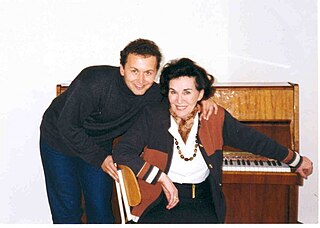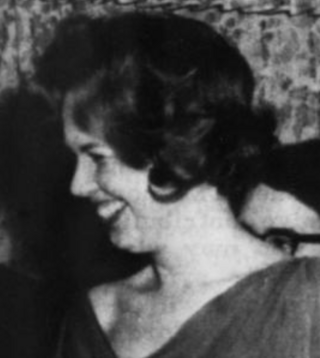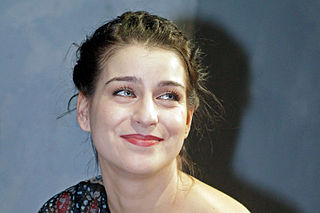Related Research Articles
A soprano is a type of classical female singing voice and has the highest vocal range of all voice types. The soprano's vocal range (using scientific pitch notation) is from approximately Middle C (C4) = 261 Hz to "high A" (A5) = 880 Hz in choral music, or to "soprano C" (C6, two octaves above middle C) = 1046 Hz or higher in operatic music. In four-part chorale style harmony, the soprano takes the highest part, which often encompasses the melody. The soprano voice type is generally divided into the coloratura, soubrette, lyric, spinto, and dramatic soprano.
A tenor is a type of classical male singing voice whose vocal range lies between the countertenor and baritone voice types. It is the highest male chest voice type. Composers typically write music for this voice in the range from the second B below middle C to the G above middle C (i.e. B2 to G4) in choral music, and from the second B flat below middle C to the C above middle C (B♭2 to C5) in operatic music, but the range can extend at either end. Subtypes of tenor include the leggero tenor, lyric tenor, spinto tenor, dramatic tenor, heldentenor, and tenor buffo or spieltenor.
A contralto is a type of classical female singing voice whose vocal range is the lowest female voice type.
A mezzo-soprano or mezzo (; Italian:[ˌmɛddzosoˈpraːno]; meaning "half soprano") is a type of classical female singing voice whose vocal range lies between the soprano and the contralto voice types. The mezzo-soprano's vocal range usually extends from the A below middle C to the A two octaves above (i.e. A3–A5 in scientific pitch notation, where middle C = C4; 220–880 Hz). In the lower and upper extremes, some mezzo-sopranos may extend down to the F below middle C (F3, 175 Hz) and as high as "high C" (C6, 1047 Hz). The mezzo-soprano voice type is generally divided into the coloratura, lyric, and dramatic.
The German Fach system is a method of classifying singers, primarily opera singers, according to the range, weight, and color of their voices. It is used worldwide, but primarily in Europe, especially in German-speaking countries and by repertory opera houses.
Spinto is a vocal term used to characterize a soprano or tenor voice of a weight between lyric and dramatic that is capable of handling large musical climaxes in opera at moderate intervals.
Jane Eaglen is an English dramatic soprano particularly known for her interpretations of the works of Richard Wagner and the title roles in Bellini's Norma and Puccini's Turandot. Her career at the Metropolitan Opera started with her Brunhilde in the Ring Cycle. Eaglen has performed at all major houses globally such as La Scalla, the Metropolitan Opera House and many others. She currently resides in Boston, MA as a voice teacher at the famous New England Conservatory where she is training the next generation of world class singers. She is the President and founder of the Boston Wagner Society. Eaglen spends her summers instructing at the prestigious Merola opera training program for emerging artists. She is very active in her community. Every year she judges several voice competitions including the Laffont-Metropolitan Opera National Council Auditions.

Leopoldine Rysanek was an Austrian dramatic soprano.

A soubrette is a female minor stock character in opera and theatre, often a pert lady's maid. By extension, the term can refer generally to any saucy or flirtatious young woman. The term arrived in English from Provençal via French, and means "conceited" or "coy".
A coloratura soprano is a type of operatic soprano voice that specializes in music that is distinguished by agile runs, leaps and trills.

Dame Gwyneth Jones is a Welsh dramatic soprano, widely regarded as one of the greatest Wagnerian sopranos in the second half of the 20th century.
Eliane Coelho is a Brazilian soprano singer. She was a soprano in the Frankfurt Opera and performed dozens of roles at the Vienna Staatsoper.
Anna Tomowa-Sintow is a Bulgarian soprano who has sung to great acclaim in all the major opera houses around the world in a repertoire that includes Mozart, Rossini, Verdi, Puccini, Heinrich Marschner,Wagner, and Strauss. She enjoyed a particularly close professional relationship with conductor Herbert von Karajan from 1973 until his death in 1989.
Sylvie Valayre is a French operatic soprano known for her versatile interpretations of lyric, spinto, and dramatic coloratura soprano parts. She sings grueling roles like Abigaille, Lady Macbeth or Turandot as well as lighter pieces like Giordano's Maddalena, Cio-Cio San, or Verdi's Desdemona at major opera houses around the world.

Radmila Bakočević, is a Serbian operatic soprano who had a major international opera career that began in 1955 and ended upon her retirement from the stage in 2004. During her career, she sang at most of the world's important opera houses, including performances throughout Europe, North and South America. She forged important long-term artistic partnerships with two opera houses during her career: the National Theatre in Belgrade and the Vienna State Opera.
A dramatic soprano is a type of operatic soprano with a powerful, rich, emotive voice that can sing over, or cut through, a full orchestra. Thicker vocal folds in dramatic voices usually (but not always) mean less agility than lighter voices but a sustained, fuller sound. Usually this voice has a lower tessitura than other sopranos, and a darker timbre. They are often used for heroic, often long-suffering, tragic women of opera. Dramatic sopranos have a range from approximately low A (A3) to "high C" (C6). Some dramatic sopranos, known as Wagnerian sopranos, have an exceptionally big voice that can assert itself over a large orchestra (of more than 80 or even 100 players). These voices are substantial, often denser in tone, extremely powerful and, ideally, evenly balanced throughout the vocal registers. Wagnerian sopranos usually play mythic heroines. Successful Wagnerian sopranos are rare and often Wagnerian roles are performed by Italianate dramatic sopranos.
A lyric soprano is a type of operatic soprano voice that has a warm quality with a bright, full timbre that can be heard over an orchestra. The lyric soprano voice generally has a higher tessitura than a soubrette and usually plays ingenues and other sympathetic characters in opera. Lyric sopranos have a range from approximately middle C (C4) to "high D" (D6). There is a tendency to divide lyric sopranos into two groups: light and full.

Kay Griffel is an American operatic spinto soprano.
He Hui, is a Chinese operatic lirico-spinto soprano known in the West and on record covers as Hui He.

Asmik Grigorian is a Lithuanian operatic soprano.
References
- ↑ Coffin, Berton (1960). Coloratura, Lyric and Dramatic Soprano, Vol. 1 . Rowman & Littlefield. ISBN 978-0-8108-0188-2.
- 1 2 Boldrey, Richard (1994). Guide to Operatic Roles and Arias. Caldwell Publishing. ISBN 978-1-877761-64-5.
- 1 2 Miller, Richard (2000). Training Soprano Voices. Oxford. pp. 9–11. ISBN 0-19-513018-9.)